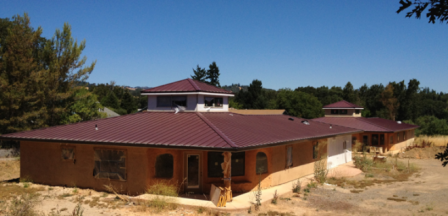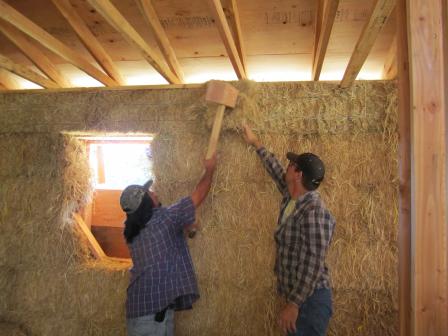Funding Opportunities for Tribal Green Building
Federal, tribal and some state agencies provide grants and loans that can be used to support tribal green building.
Funding Resources
 (All federal funding opportunities can be found at Grants.gov)
(All federal funding opportunities can be found at Grants.gov)
- Environmental Protection Agency (EPA)
- Department of Energy (DOE)
- Housing and Urban Development (HUD)
- Database of State Incentives for Renewables and EfficiencyExit
- Federal Tax Credits for Energy Efficiency
Environmental Protection Agency
Indian General Assistance Program (GAP)
 Pinoleville Pomo Nation used HUD funding to build green homes built with local straw and earthen materials and EPA GAP funding to support the development of Tribal Green Building Codes.
Pinoleville Pomo Nation used HUD funding to build green homes built with local straw and earthen materials and EPA GAP funding to support the development of Tribal Green Building Codes.The goal of GAP (CFDA 66.926) is to assist tribes and intertribal consortia in developing the capacity to manage their own environmental protection programs, and to develop and implement solid and hazardous waste programs in accordance with individual tribal needs and applicable federal laws and regulations. Funding can be used to fund training and assistance associated with green and healthy building as well as sustainable building code development, and the development of inspections and enforcement programs under provisions for building legal and administrative capacity. Encouraging radon resistant construction is explicitly covered.
Eligibility: Federally Recognized Tribes and Inter-tribal Consortia
Award Cycle Dates: Annually
Award Amounts: Varies
Details: Indian Environmental General Assistance Program (GAP)
How to apply: Grants.gov
EPA Smart Growth Grants and Other Funding
EPA's Office of Sustainable Communities occasionally offers grants to support activities that improve the quality of development and protect human health and the environment.
Details: EPA Smart Growth Grants and Other Funding
U.S. Department of Energy (DOE)
Learn about Department of Energy grants. loans and technical assistance opportunities for tribes and Alaska Native villages to support energy systems, renewable energy and energy efficiency.
- Current Funding Opportunities
- Energy Development Assistance Tool for Tribes
- Department of Energy Tribal Energy Products Database
- Past Funding Opportunities and Related Information
U.S. Department of Housing and Urban Development (HUD)
HUD's Funding Opportunities
The Department of Housing and Urban Development's Notice of Funding Availability (NOFA) Forecast lists competitive grant opportunities that may be available.
Healthy Homes Technical Studies Grant Program
Assists academic institutions, non-profit and for-profit organizations (provided no fees are charged for services), states, Native American tribes and local governments to develop the most promising, cost-effective methods for identifying and controlling housing related hazards, and build local capacity to operate sustainable programs to prevent, minimize, and control housing-related hazards in eligible residences.
Eligibility: Native American Tribes, states, local governments, academic institutions, non-profit organizations
Award Cycle Dates: Annually, June August.
Award Amounts: Each year roughly 3 cooperative agreements of up to $1,000,000 per agreement. Applicants are not required to provide a match to participate.
Details: Healthy Homes Technical Studies Grant Program
How to apply: Grants.gov
Healthy Homes Demonstration Grant Program (HHD)
The Healthy Homes Demonstration Grant Program assists academic institutions, non-profit and for-profit organizations (provided no fees are charged for services), States, Native American Tribes and local governments to address environmental triggers that may be contributing to the child's illness, conduct education and outreach that furthers the goal of protecting children from environmentally induced illness, and build capacity in the target community to assure long-term progress of healthy homes efforts.
Eligibility: Native American Tribes, not-for profit, for-profit firms located in the United States, state and local governments, and colleges and universities.
Award Cycle Dates: Annually.
Award Amounts: Each year roughly 5 cooperative agreements of up to $1M per agreement. Applicants are not required to provide a match to participate.
More Information: Healthy Homes Demonstration Grant Program (HHD)
How to apply: Grants.gov
Indian Housing Block Grant (IHBG)
This is a formula grant that allows tribes or tribally designated housing entities (TDHEs) to provide a range of affordable housing activities on a reservation or Indian area. These activities are identified and described in an Indian Housing Plan (IHP) which is prepared each year and submitted to HUD for review and compliance with the Native American Housing Assistance and Self Determination Act (NAHASDA). Eligible activities include model activities that provide creative approaches to solving affordable housing problems, housing development, and assistance to housing developed under the Indian Housing Program.
Eligibility: Federally recognized Indian tribes or their tribally designated housing entity (TDHE), and a limited number of state recognized tribes who were funded under the Indian Housing Program authorized by the United States Housing Act of 1937 (USHA). With the enactment of NAHASDA, Indian tribes are no longer eligible for assistance under the USHA.
Award Cycle Dates: Annually
Award Amounts: Varies
More Information: Indian Housing Block Grant (IHBG)
How to apply: Grants.gov
Indian Community Development Block Grant
Indian tribes and Alaska Native villages may use block grants to improve the housing stock, provide community facilities, make infrastructure improvements, and expand job opportunities by supporting the economic development of their communities.
- Comprehensive Planning – Comprehensive planning [can potentially include tribal building code planning/development] can be proposed as part of any otherwise eligible project. Comprehensive planning is subject to the 20% limitation on the grant for planning and administration.
- Community Based Development Organization (CBDO) Assistance – Grantees may provide assistance to CBDOs to undertake activities related to neighborhood revitalization, community economic development, or energy conservation.
- Code Enforcement – Code enforcement in deteriorating or deteriorated areas where such enforcement, together with public or private improvements, rehabilitation, or services to be provided, may be expected to arrest the decline of the area.
- Rehabilitation Services – Services such as rehabilitation counseling, energy auditing, preparation of work specifications, loan processing, inspections, and other services related to assisting owners, tenants, contractors, and other entities.
- Energy Efficiency – Improvements to increase the efficient use of energy in structures.
- Water Conservation – Improvements to increase the efficient use of water through such means as water saving faucets and shower heads and repair of water leaks
- Lead Based Paint Abatement and Evaluation – Lead based paint abatement and evaluation can be proposed under a housing rehabilitation project.
- Renovation of Closed Buildings – such as closed school buildings, for use as an eligible public facility or to rehabilitate such buildings for housing
Eligibility: Any Indian tribe, band, group, nation, or tribal organization, including Alaska Indians, Aleuts, and Eskimos, and any Alaska Native village that is eligible for assistance under the Indian Self-Determination and Education Assistance Act or which had been eligible under the State and Local Fiscal Assistance Act of 1972.
Award Cycle Dates: Annually, May August
Award Amounts: $238,225 to $5,550,000; Average $688,030.
More Information: Indian Community Development Block Grant
How to apply: Grants.gov
Indian Home Loan Guarantee Program
- Purchase of an existing home;
- Construction of a home (stick-built or a manufactured home on a permanent foundation);
- Rehabilitation loans;
- Purchase and rehabilitation;
- Refinancing (Rate and Term, Streamline, Cash Out).
Eligibility: American Indians or Alaska Natives who are enrolled members of a federally recognized tribe; a member of an Alaska Village and Regional Corporation established pursuant to the Alaska Native Claims Settlement Act; an Indian tribe; a Tribally Designated Housing Entity (TDHE); an Indian Housing Authority (IHA).
Application Cycle Dates: Continuous.
Loan Amounts: Varies
More Information: Indian Home Loan Guarantee Program
How to apply: Application Process for Tribal Borrowers and Application Process for Tribe and Tribally Designated Housing Entities.
Title VI Tribal Housing Activities Loan Guarantee Program
The purpose of the Title VI loan guarantee is to assist Indian Housing Block Grant (IHBG) borrowers who want to finance eligible affordable housing activities, but are unable to secure financing without the assistance of a federal guarantee. A federal guarantee is a pledge by the U.S. Government to repay all or a portion of the unpaid principal balance and accrued interest for an obligation by a borrower to a lender after a default under the terms of the repayment agreement.
- Create new housing
- Rehabilitate housing
- Build infrastructure
- Construct community facilities
- Acquire land do be used for housing
- Prepare architectural and engineering plans
- Fund financing costs
Eligibility: A federally recognized tribe who receives IHBG funds; a TDHE authorized by a tribe to receive IHBG funds and is authorized to make obligations and pledge IHBG funds as security for those obligations.
Application Cycle Dates: Continuous
Loan Amounts: Varies
More Information: Title VI Tribal Housing Activities Loan Guarantee Program
How to apply: See instructions at the Title VI Tribal Housing Activities Loan Guarantee Program website.
